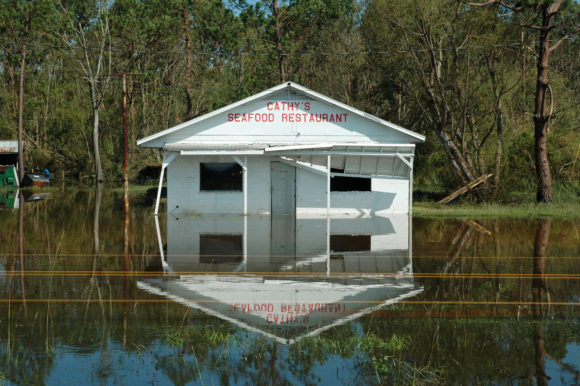As the climate crisis worsens, more Americans will be forced from their homes. Many won’t be able to afford it, and the U.S. isn’t prepared for a massive, government-subsidized migration away from flood-prone areas, according to the first comprehensive analysis of Federal Emergency Management Agency data.
In the end, it is the nation’s poorest who may be left behind.
Americans have voluntarily sold more than 43,000 properties in high-risk areas to the government since 1989, according to a new analysis published Wednesday in Science Advances. FEMA’s Hazard Mitigation Grant Program has bought properties sprinkled among one-third of all U.S. counties, spread over 49 states, Puerto Rico, Guam and the U.S. Virgin Islands. After the properties are bought, the structures are demolished and the land remains open, ready to absorb future flood waters.
This 30 year-trickle is nothing compared with the great climate exodus to come. The potential number of homes that may be abandoned is staggering, said A.R. Siders, a co-author and assistant professor at University of Delaware’s Disaster Research Center. “There are 49 million housing units in at-risk areas on the U.S. coast, and over $1 trillion worth of infrastructure within 700 feet of the coast,” she said. The government isn’t prepared to relocate even one-tenth of that, if it needed to, Siders said.
FEMA did not immediately respond to a request for comment.
The problem will only be compounded as extreme weather intensifies. A separate research paper published this week in the Proceedings of the National Academy of Sciences found “robust evidence” that natural disasters are carrying greater risk and expense. The authors said their findings give credence to long-controversial estimates of future costs embedded in climate-economic models.
And while costs from average weather events may not be changing much yet, damage from extreme events is. Economists call this phenomenon a “fat tail,” described most famously by Harvard economist Martin Weitzman.
Under the FEMA program, most buyouts have occurred in counties with higher incomes, education, populations and population density, according to the new analysis—places where homeowners are more likely to afford adaptive infrastructure measures such as elevating houses above flood levels.
Low-income and rural areas have received fewer buyouts. While the FEMA data don’t indicate the identify of homeowners by race, a recent investigation by NPR found that federal post-disaster aid goes disproportionately to white communities. The concentration of buyouts is a signal that managed-retreat programs may need adjustment, the researchers said.
Instead of being out front, states with the highest amount of flood damage (Florida, Mississippi and Louisiana) fell in the middle of the pack when it came to buyouts. Historically, the availability of federal flood insurance and infrastructure support made those states—which face an increasing risk of unprecedented storm damage as hurricanes intensify and linger longer—appear less risky to live in than may actually be the case.
Researchers identified several other problems with FEMA’s program. The size of buyouts have decreased over time, with just one to three properties covered in a single project. It takes an average of almost six years to complete a buyout, often leaving homeowners in financial difficulty, according to a recent report by the Natural Resources Defense Council
“The way that we’re currently dealing with these issues is a sort of unmanaged retreat in a lot of places,” said Anna Weber, senior policy analyst at the NRDC. “That’s just not working for people right now.”
Americans aren’t going to sit and watch their homes flood, said Katharine Mach, lead author of the FEMA study and associate professor at the University of Miami. Some will take buyouts. Some will build levees. Regardless, parts of the nation “might look more like Venice in the future.”
Was this article valuable?
Here are more articles you may enjoy.


 US Lawmaker Unveils Bill Requiring Manual Car-Door Releases
US Lawmaker Unveils Bill Requiring Manual Car-Door Releases  Musk’s xAI Faces California AG Probe Over Grok Sexual Images
Musk’s xAI Faces California AG Probe Over Grok Sexual Images  NYC Sues Delivery App Over Lost Pay in New Mamdani Crackdown
NYC Sues Delivery App Over Lost Pay in New Mamdani Crackdown  Tesla, EEOC Plan Talks to Settle Factory Racism Suit
Tesla, EEOC Plan Talks to Settle Factory Racism Suit 